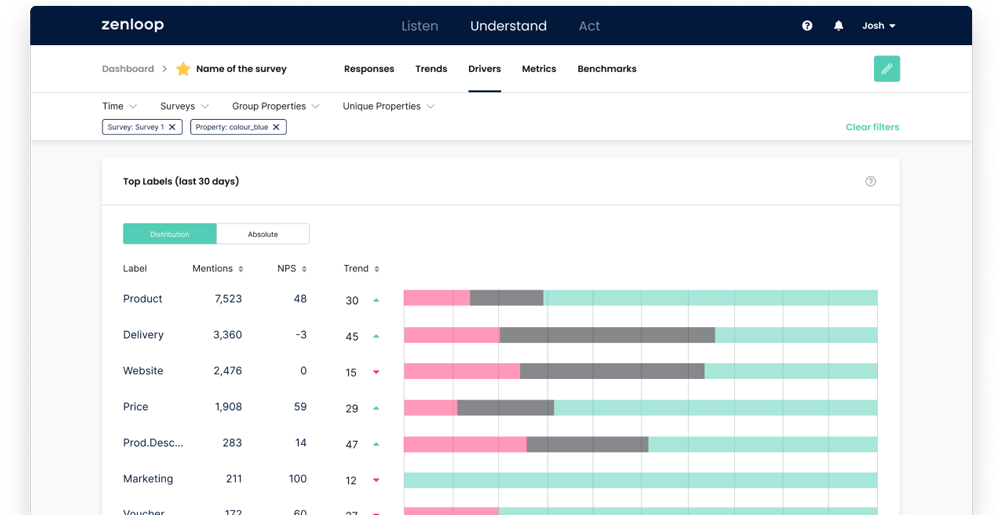The Employee Net Promoter Score
Instrument for Employee Retention & Crisis Management
The eNPS (short for Employee Net Promoter Score) is a method for measuring employee loyalty and provides information on how likely employees are to recommend their employer to friends and acquaintances. It is also suitable as a tool for successful crisis management.
Gain Insights through Comments
Smart Labels and Sentiment Analysis evaluate comments and provide insights into employee feedback.
Utilize Loyalty & Strengthen the Employer Brand
With the eNPS, companies can rely on the potential of loyal employees to promote recommendations and reviews. This strengthens the employer brand.
Support & Increase Employee Loyalty Deliberately
Use employee feedback to uncover dissatisfied team members and their motives before they leave.
Efficient Crisis Management with the eNPS
The eNPS enables companies to obtain targeted input for crisis management, identifying insights of employee satisfaction, and utilizing them.
What is the eNPS®
A Guide to the Employee Net Promoter Score
For a considerable time, the eNPS and its key indicators have been an important topic in HR and personnel departments.
With the Employee Net Promoter System, companies can find out how satisfied employees are with their working environment, what the status of employee retention is, and which topics are particularly important to employees. Among managers and employees the eNPS methodology is very popular due to its easy approach. Based on the results and the knowledge gained, companies can take specific measures to make their employees happy and retain them in the workplace in the long term.
In this guide, we explain the eNPS in detail and provide information on how to apply this metric in practice. Furthermore, we point out why the eNPS is a valuable tool for customer retention not only in times of crisis.
Table of Contents
- About the Employee Net Promoter Score
- Categorisation within the eNPS
- Calculating the eNPS
- Interpreting the eNPS
- Application and Advantages of the Employee Net Promoter Score
- Recommendations: How to Use the eNPS
- Closing the Loop: Tips for Successfully Utilising the eNPS
- Basic Principles for Implementing “Closing the Loop” Measures
- How to Improve the eNPS
- The eNPS as a Tool in Crisis Management
- Criticism and Limitations of the Employee Net Promoter Score
About the Employee Net Promoter Score
The eNPS is a variation of the Net Promoter Score (NPS), which was developed as a benchmark for customer loyalty by Fred Reichheld, Bain & Company, and Satmetrix.The eNPS, however, determines employee satisfaction and loyalty. Following the logic of the classic Net Promoter System, the eNPS consists of two questions. In the first step, the employee responds to a quantitative questionnaire in order to identify how likely he is to recommend his employer:
On a scale of 0 (unlikely) to 10 (very likely) how likely are you to recommend your employer?
These values, however, do not explain the employee’s motives. Why is an employee inclined to recommend a company as an employer or not? Thus, to really understand the given score, a more comprehensive survey is necessary.
In a second step, the employee is asked to explain the reason behind his decision in a description field and this qualitative data is added on top of the quantitative score:
Why did you choose the score XX?
With the answers and comments, the company gains important knowledge which forms a valuable database to act upon. The employer can subsequently target retention measures at the unsatisfied employees.
Categorisation within the eNPS
Similar as with the NPS, the employee responses are clustered into three categories according to the ratings given:
- Detractors (Score 0 to 6)
- Passives (Score 7 to 8)
- Promoters (Score 9 to 10)
For each category, employees tend to show the following characteristics:
Detractors: These tend to be dissatisfied employees who show a high risk of leaving the company. However, personalised measures and targeted problem solutions can help to tie them more strongly to the company and thus win them back.
Passives: These employees stand in between detractors and promoters on the scale. They are susceptible to offers from other employers and should be more closely tied to the company by using adequate measures.
Promoters Employees in this category can be understood as loyal employees. They are satisfied with their employer and are very likely to recommend the employer to third parties. They can be won over as advocates as they identify strongly with the company and thus carry the corporate culture into the rest of the team.
Calculating the eNPS
The score is calculated in the same way as in the Net Promoter System by subtracting the percentage of detractors from the percentage of promoters. The result is an absolute number between -100 and +100. Passives are not directly considered in the calculation.
eNPS = “Number of Promoters in percent” – “Number of Detractors in percent”
An example: If 65 percent of employees are promoters, 15 percent are detractors and the remaining 20 percent are passive employees, the result is a positive eNPS of 50.
But what do these results mean? What score is considered to be a good eNPS?
Interpreting the eNPS
To interpret the eNPS correctly, it is helpful to draw parallels to the original Net Promoter Score. Many factors shape the definition of a “good” or “bad” result and the score has to be considered relatively. Generally, a NPS of
- -100 to 0 reflects the danger zone,
- 1 to 30 means a good result,
- 31 to 75 is a very good figure,
- 76 to 100 reflects an outstanding NPS.
These categorisations can be applied to the eNPS analogously:
Danger Zone: There are more detractors than promoters. Companies with this score lose employees frequently and have a rather negative public image.
Good: Companies with this score can mostly meet their employees’ expectations and can rely on a loyal employee base.
Very Good: Companies with this score recognise a high level of loyalty within their workforce. The vast majority of employees are satisfied with the working conditions and the employer in general.
Outstanding: For these companies, focusing on employee satisfaction and retention is an integral part of the corporate culture and forms the image of the employer brand.
Application and Advantages of the Employee Net Promoter Score
Probably the most remarkable advantage of the eNPS is for companies to get a quick and easy overview of the loyalty of their own employees. Besides capturing loyalty, satisfaction, and commitment there are many other factors that benefit from measuring and improving the eNPS. Some of them are:
- Performance
- Productivity
- Profit
- Innovation
- Creativity
- Employer brand
- Employee retention
Furthermore not to be neglected: the use of eNPS increases the morale among employees. Employees appreciate being asked for their opinion and they value being heard and integrated in shaping processes. Being able to play an active role in shaping the corporate culture and, where applicable, the structure of the company increases the emotional bond with the employer.
Recommendations: How to use the eNPS
To picture the attitude of the team as accurately as possible, a few things must be taken into consideration. These are our best practices on how to use the eNPS:
- Survey as many employees as possible
The more feedback a company gets from its employees, the more insightful, diversified, and meaningful the results are going to be. - Choose the right survey channel
There are many options to run an eNPS survey. The most common are tablet surveys, links, website overlays on internal pages, and e-mails. The most convenient and easy for employees is a survey via email. - Send reminders to increase response rates
As usual with any survey, not all participants will answer immediately or at all. However, e-mail surveys allow companies to remind participants with a follow-up message after some time. - Anonymity fosters open feedback
In general, we recommend offering anonymous surveys because they encourage employees to respond honestly and not to withhold critical feedback or negative feelings. - Collect feedback on a regular basis
Asking employees for feedback once only represents a snapshot at that time. The real strength in eNPS however, lies in comparability, development, and change over time. We suggest conducting surveys regularly in the form of a drip-eNPS in order to be able to recognize trends and progress reliably.
Closing the Loop: Tips for Successfully Utilising the eNPS
In the end, as with any metric or method, what is much more important than the survey itself is the knowledge gained from it and how to translate this knowledge into profitable measures as successfully as possible.
Introducing such measures offers many advantages and can be used to achieve a variety of goals. Companies that aim to successfully introduce “Closing the Loop” measures therefore should:
- Show their employees that they care
By automatically sending “thank you emails”, companies can show their employees appreciation for their time and feedback. By listening to their employees, addressing criticism and concerns, and responding to suggestions, companies make them feel noticed and valued. This can strengthen the employees’ emotional bond with the company. - Uncover underlying causes for potential problems and dissatisfaction
Employee feedback provides valuable information that can reveal profound problems within the company. Being able to provide anonymous feedback gives employees the courage to address issues they might otherwise not feel comfortable talking about. - Use promoters for company recommendations
Attracting new employees via recommendations of friends and family increases the likelihood of a good person-organization fit. This has a positive effect on important factors such as job satisfaction, performance, motivation, as well as employee loyalty and in turn, reflects positively on the eNPS as well as the company’s finances through lower hiring costs. - Recover Detractors
By purposefully addressing the detractor’s specific complaints and criticism, satisfaction and employee loyalty can be increased, and thus a migration is prevented. Often recovered detractors become the most loyal employees. - Sustainably increase employee loyalty
‘The purpose of the eNPS query is not only to identify the problems and reasons behind employee turnover but above all to address them. Targeted actions based on employee feedback are essential to sustainably increase employee loyalty.# - Optimize “Closing the Loop” processes
Visible changes and employees recognizing that their feedback is actually being implemented increases the probability of them continuing to provide valuable feedback in the future. Closing the feedback loop enables continuous improvement and is thus strengthening employee loyalty.
Basic Principles for Implementing “Closing the Loop” Measures
There are many different measures leading to success when it comes to closing the feedback loop. Of course, these vary depending on the company and the problem areas. However, there are some actions that can be taken universally.
These include regular internal newsletters that focus on employee feedback and discuss related improvements and progress. In addition, important topics can also be covered in greater detail on the intranet or an equivalent platform by publishing announcements or articles.
If it becomes apparent from the initial feedback that, for example, employees from a particular team or location are primarily affected, requesting additional feedback from that group of people can be helpful. Sharing results with relevant team leads and integrating them into the processes can ensure fast and effective execution
When implementing “Closing the Loop” processes, it is particularly important that companies proceed not only quickly, but also logically and target-oriented. All measures should therefore be based on the following four basic principles:
- Define and measure KPIs
In order to measure the success of “Closing the Loop” measures, KPIs must be defined and evaluated. Depending on the measure taken, suitable KPIs can include the number of recovered detractors, the number of recommendations, or future response rates. - Act quickly and rationally
Responding quickly to negative feedback is definitely crucial to retaining employees. However, it is equally important to act logically and deliberately as well as to find individual solutions. Which measures are suitable should be decided based on the feedback received. - Pay attention to all employees and utilize their feedback
Although it poses a great challenge to respond to all employees’ concerns at once, it is important to not only focus on certain problems and thus neglect other employees and their feedback. Grouping and prioritizing issues can definitely be useful here, but care should be taken to ensure that “smaller” issues are not ignored. - Renew strategies
Once initial problems have been solved and detractors are satisfied, the next step should be to record empirical values. Strengthening employee loyalty in the long term can only be successful if companies rethink and renew their strategies regularly based on the experience gained.
How to Improve the eNPS
What is valid for the interpretation of the score also applies for the benchmarking: it depends on many factors. That is why a company’s own score can not easily be compared to eNPS results of another organization. Reasons for employees to be loyal at one firm are incomparable to those who turn their back on another. It does not only depend on the work environment provided by an employer, but also on the personal wishes and expectations of the employees.
Instead of spending energy on creating insignificant benchmarks or comparable conditions, companies should rather focus on improving their own performance regarding the eNPS.
With the following five tips companies can improve their Employee Net Promoter Score
- Define scale and frame for the measurement
As in any other process or project, the question of the status quo and the objectives arises. What is the exact goal? Which score should be achieved? What is the time frame to achieve this goal? The answers to these questions form the basis and benchmark for improving the eNPS and thus employee retention. - Using software for collecting and evaluating eNPS feedback
Instead of implementing and evaluating employee surveys manually, the use of appropriate software solutions is recommended. Through software, eNPS surveys can be generated with small efforts, and the feedback is analyzed automatically. Thanks to smart labels, semantic text evaluation, and sentiment analysis, the feedback can be evaluated easily. - Collect feedback frequently and regularly
An organization should ask the employees in regular intervals for their feedback. A company can draw many advantages from that. Firstly, it provides the ability to compare and look at the development over a fixed period of time. A firm can also collect more feedback over time so that the additional data items allow for a better evaluation. Moreover, subjects that emerge as particularly important and problematic in the initial queries can then be addressed specifically. By adapting the questionnaire in the follow-up surveys, firms can monitor how employees reacted to the measures and whether there have been improvements in the problematic areas. - Focus on transparent corporate communication
Collecting employee feedback is only the first step. Subsequently, it is important to implement transparent communication methods regarding the feedback received. This refers to the status quo as well as to specific actions and measures for internal improvement. This way, employees feel integrated into designing corporate culture and work processes and are more likely to contribute in the future. - Provide necessary resources for improvement measures
As mentioned previously, collecting valuable feedback through eNPS surveys is only the first step. Companies must provide certain resources to implement the improvements and necessary actions in order to successfully utilize the Employee Net Promoter System. Above all, it is essential to appoint one person who will take responsibility for the topic, including the planning of objectives, strategies, time, and budget management.
Companies have to view the improvement of the eNPS as an ongoing process that can only be successful in cooperation with the entire workforce. If employees and managers work together to shape and improve working conditions, processes, and employee satisfaction, companies will be pleased to have loyal employees. Not only long and reliable work relationships, which save costs and time, are ensured, but also the employer brand can be strengthened through positive word of mouth.
The eNPS as a Tool in Crisis Management
Especially in times of crisis, the eNPS is a helpful tool in Employee Experience Management. The internal climate is a crucial factor for guiding a company through difficult times and therefore worries and fears of employees should not be underestimated. Hence, it is advisable to gather feedback from the team on a regular basis.
Through a combination of quantitative and qualitative feedback, the team atmosphere can be assessed quickly. By using an Employee Net Promoter System, feedback is stored in one central place and does not have to be collected by different supervisors, which ensures clarity and completeness. Based on qualitative feedback provided in the text box, critical topics can be bundled into specific groups. These topics should be addressed transparently and continuously in order to eliminate insecurities as early as possible.
In times of crisis, a company’s situation can often change within a short time. This is where the eNPS offers the advantage of only taking a few seconds to respond to. In addition to a high response rate, this means that the eNPS survey can be repeated at short intervals without bothering employees with time-consuming questionnaires, ensuring a continuous monitoring of the development within the company.
Companies that are communicating successfully and performing excellent Employee Experience Management during the crisis will be rewarded with above-average employee loyalty after this exceptional situation.
Criticism and Limitations of the Employee Net Promoter Score
The Employee Net Promoter Score can provide a wide range of information and thus serve as a valuable source of information on employee satisfaction and for identifying potential problem areas. Nevertheless, there are some points that companies should be aware of when using the eNPS:
- Internal indicator versus external benchmark
Each company has a unique culture, mentality, and different norms and values, which is also reflected in its employees. Comparing the eNPS of one company with that of another is therefore very difficult. Although external benchmarking is a very popular tool amongst many companies, it should be largely avoided in this case. Instead, companies should use their eNPS as an internal KPI. The purpose should lie in addressing issues and strengthening employee loyalty for the benefit of the company and its employees, not in reaching a higher value than other companies. Competing with others can easily lead to losing sight of the actual goals. - Not the value itself counts
The eNPS as a stand-alone value does not provide many insights. However, companies may be inclined to be satisfied with simply collecting feedback and not taking follow-up actions. Factors such as the composition and history of the value, though, play a crucial role. For example, is the value created by many passives or rather by a large number of detractors and promoters? Has the eNPS been surveyed before and how does the current value compare? What issues are addressed in the comments? If these aspects are not taken into account, it is not possible to take appropriate action, which leads to disappointed and frustrated employees. - Surveys the satisfaction with the company and not with activities
Satisfaction with the general working environment depends on many factors. In addition to satisfaction with the company itself, they include above all satisfaction with individual activities. However, the eNPS does not allow conclusions about this aspect. An employee may be dissatisfied with his or her activities despite a high level of satisfaction with the company as a whole. In order to determine this, activity-related questions must be added. - Does not cover all aspects
The eNPS mainly allows conclusions about loyalty and retention of employees, as well as employer attractiveness. Although these are important indicators, little or no conclusions can be drawn about other important factors such as employee engagement and motivation. Companies should be aware of this limitation and, if necessary, ask about these and other relevant factors separately.
Despite these limitations, the eNPS can be a helpful tool for employers to uncover uncertainties and problems, especially in times of crisis. It is, however, important that companies are aware of the above-mentioned aspects and, if necessary, use additional tools or methods in order to make decisions about actions to be taken.
zenloop can help your business, too.









